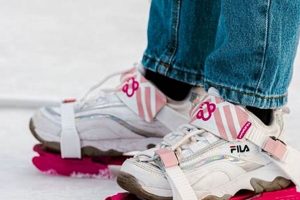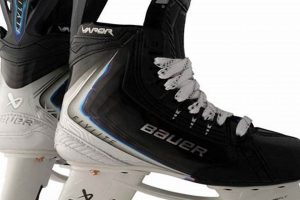The correlation between footwear dimensions and ice skate fitting presents a common point of inquiry. Determining the appropriate skate size often requires consideration beyond simply matching the measurements of street shoes. Differences in manufacturer sizing conventions, internal boot padding, and desired fit preferences can all impact the final skate selection. As an example, an individual who typically wears a size 9 shoe may find that a size 8 or 8.5 skate offers a more secure and performance-oriented fit.
Accurate skate sizing is crucial for optimal performance and injury prevention. Skates that are too large can lead to instability and reduced control, while overly small skates can cause discomfort and blisters. Historically, skaters relied on trial and error, often enduring poorly fitting skates. Modern advancements in skate technology and fitting techniques emphasize precise measurements and personalized adjustments to achieve a superior fit, contributing to enhanced skating experiences and reduced risk of foot-related issues.
This article will explore the nuances of skate fitting, offering guidance on how to measure foot dimensions, interpret sizing charts from various manufacturers, and account for individual foot characteristics to ensure the best possible skate fit.
Ice Skate Sizing Considerations
Selecting the correct ice skate size is paramount for performance, comfort, and safety. Consider the following guidelines to optimize skate fit based on comparisons to standard shoe sizing.
Tip 1: Measure Foot Dimensions. Prior to consulting size charts, measure the length and width of both feet in millimeters. This provides a baseline for comparing to manufacturer specifications and accounting for variations in foot size.
Tip 2: Consult Manufacturer Size Charts. Each skate manufacturer employs unique sizing conventions. Refer to the specific sizing chart for the brand and model of skate being considered. Note any instructions regarding allowances for socks or fit preferences.
Tip 3: Account for Sock Thickness. Skate fitting should be performed with the type of socks that will be worn during skating. Thicker socks may necessitate a larger skate size, while thinner socks may require a tighter fit.
Tip 4: Consider Foot Shape. Individuals with wide feet may require skates with a wider boot profile, or may need to size up to accommodate the width. Similarly, skaters with narrow feet may benefit from narrower skate models or aftermarket fitting adjustments.
Tip 5: Perform a “Pencil Test.” With the skater standing in the skates, insert a pencil vertically into the skate behind the heel. If the pencil can be inserted easily, the skates are likely too large. If the pencil cannot be inserted, the fit may be appropriate or too snug.
Tip 6: Prioritize Heel Lock. Proper skate fit ensures the heel is securely locked into the heel cup of the skate. Excessive heel lift indicates a skate that is too large, while heel discomfort suggests a skate that is too small or narrow.
Tip 7: Seek Professional Fitting Assistance. If uncertainty persists, consult a qualified skate fitter at a reputable sporting goods store. Professional fitters possess the expertise to assess foot characteristics and recommend the optimal skate size and model.
Accurate skate fitting, grounded in the relationship between footwear dimensions and skate size, minimizes the risk of blisters, lace bite, and other foot-related issues, ultimately enhancing the skating experience.
The following sections will elaborate on specific fitting techniques and address common sizing misconceptions.
1. Manufacturer Variations
The disparity in sizing standards across ice skate manufacturers significantly complicates the correlation between shoe size and ice skate fit. Uniformity in sizing is absent; therefore, direct comparisons are unreliable and can lead to improper skate selection.
- Inconsistent Size Increments
Manufacturers utilize varying size increments. Some brands may use half sizes more frequently than others, or their half sizes may represent different length adjustments. This inconsistency prevents a direct translation of shoe size to skate size, even within the same general size range. For instance, a half size increase in one brand might equate to a full size increase in another, leading to a skate that is either too snug or excessively loose.
- Boot Last Discrepancies
The boot last, the foot-shaped mold around which the skate boot is constructed, differs substantially between manufacturers. Lasts influence the internal volume and shape of the skate, affecting how a foot fits within the boot. A skate from one manufacturer built on a wider last may accommodate a wider foot at a smaller labeled size compared to a skate from a different manufacturer using a narrower last. This means that a skater may require a larger size in a narrow-lasted skate to achieve the same fit as a smaller size in a wide-lasted skate.
- Sizing Chart Interpretations
Sizing charts, while intended to guide consumers, often lack uniformity. Some charts provide measurements based on foot length in millimeters, while others use shoe size conversions. Even when using millimeter measurements, variations in how these measurements translate to specific skate sizes exist between manufacturers. A skater’s foot measuring 270mm might be designated as a size 8 in one brand’s chart but a size 8.5 or even 9 in another’s.
- Regional Sizing Conventions
While less prevalent, some manufacturers may incorporate regional sizing conventions into their skate sizing. North American, European, and Asian sizing systems differ, and although conversions are generally available, discrepancies can arise. A skate labeled with a European size may not precisely align with its equivalent North American size, requiring careful consideration and cross-referencing.
Given these manufacturer-specific variations, relying solely on shoe size as a determinant for ice skate selection is imprudent. A thorough understanding of a manufacturer’s sizing chart and boot last characteristics, coupled with precise foot measurements, is essential for achieving a proper and comfortable fit.
2. Foot Measurement Accuracy
Precise foot measurement forms the cornerstone of accurate ice skate sizing, directly impacting the correlation between shoe size and optimal skate fit. Accurate measurements mitigate the discrepancies arising from varied manufacturer sizing conventions and individual foot characteristics.
- Importance of Brannock Device
The Brannock device serves as the industry standard for obtaining accurate foot length and width measurements. Utilizing this device, rather than relying on self-measurements or estimations, significantly enhances the precision of size determination. For example, a seemingly minor discrepancy of a few millimeters in foot length can translate into a considerable difference in perceived skate fit and performance.
- Accounting for Foot Width
Foot width is a critical but often overlooked factor in skate sizing. A foot may measure a specific length but require a wider or narrower skate boot to accommodate its overall volume. Ignoring foot width can result in pressure points, discomfort, and compromised skating performance. Measurements taken with a Brannock device incorporate width considerations, providing a more comprehensive assessment.
- Addressing Bilateral Foot Size Discrepancies
Most individuals exhibit slight variations in size between their left and right feet. Measuring both feet independently and selecting a skate size based on the larger foot ensures a comfortable and functional fit. Ignoring this asymmetry can lead to discomfort or injury, particularly if the smaller foot is forced into an ill-fitting skate.
- Impact of Measurement Timing
Foot size can fluctuate throughout the day due to swelling and activity. Taking measurements later in the day, after the feet have had a chance to expand, provides a more representative indication of the foot’s maximum size and ensures the selected skates will remain comfortable even during extended skating sessions.
The accuracy of foot measurements directly influences the effectiveness of any skate sizing system. Reliance on imprecise methods or estimations diminishes the predictive power of the “ice skate size vs shoe size” comparison. Investment in professional fitting services and utilization of standardized measurement tools are essential for achieving optimal skate fit, regardless of an individual’s typical shoe size.
3. Intended Use Impact
The intended use of ice skates exerts a significant influence on the correlation between skate size and shoe size. Different skating disciplines necessitate specific fit characteristics, thereby altering the optimal skate size relative to standard footwear dimensions.
- Hockey Skate Precision
Hockey players generally favor a snug fit to maximize agility and responsiveness. This often translates to selecting hockey skates one to one-and-a-half sizes smaller than their typical shoe size. The tighter fit enhances energy transfer during skating strides and facilitates rapid changes in direction. A recreational skater using hockey skates may prioritize comfort over performance and opt for a slightly larger size.
- Figure Skate Support
Figure skates, designed for intricate maneuvers and landings, demand a precise fit to provide adequate ankle support and control. The sizing strategy often involves a closer correlation to shoe size, with minor adjustments based on individual foot morphology. Overly large figure skates can compromise stability and increase the risk of injury during jumps and spins.
- Recreational Skate Comfort
Recreational skates, intended for casual skating and general enjoyment, typically prioritize comfort over high-performance characteristics. This often allows for a slightly more generous fit, potentially aligning closer to shoe size or even requiring a half-size increase. The relaxed fit minimizes pressure points and enhances comfort during extended skating sessions.
- Speed Skate Efficiency
Speed skates, engineered for maximizing velocity and aerodynamic efficiency, necessitate a highly specialized fit. Skaters often seek a very snug, almost compression-like fit to minimize energy loss and enhance blade control. This often requires a skate size smaller than the skater’s typical shoe size, sometimes necessitating custom-molded boots to achieve the desired fit profile.
The interplay between intended use and skate sizing underscores the importance of considering specific skating demands when determining the appropriate skate size relative to shoe size. A generalized comparison is insufficient; rather, a nuanced understanding of the fit requirements associated with each skating discipline is crucial for optimal performance and injury prevention.
4. Liner Compression Allowance
The factor of liner compression significantly influences the appropriate ice skate size relative to shoe size. Skate liners, typically constructed of foam or gel materials, provide cushioning and contribute to overall fit. Over time, these liners compress due to repeated use and pressure, resulting in increased internal volume within the skate boot. Failure to account for this compression can lead to the initial selection of skates that become excessively large and offer inadequate support after a period of use.
The impact of liner compression varies based on the liner material and the frequency of skate usage. Liners composed of higher-density foams exhibit less compression compared to those made of softer, less resilient materials. For instance, a skater who uses their skates several times per week will experience more rapid liner compression than someone who skates infrequently. As a result, skaters with higher usage rates may benefit from selecting a skate size that initially feels slightly snug, anticipating that the liner will compress over time to achieve a more comfortable and appropriate fit. Conversely, infrequent skaters may prioritize immediate comfort and select a size that accommodates the liner’s initial volume.
Accurate consideration of liner compression allowance requires a degree of experience and informed judgment. Consulting with experienced skate fitters can provide valuable insights into the compression characteristics of specific skate models and liner materials. By factoring in anticipated liner compression, skaters can mitigate the risk of selecting skates that become oversized and compromise performance and safety. This understanding is particularly critical for competitive skaters who demand a precise and consistent fit throughout the lifespan of their skates.
5. Fitting Expertise Importance
The correlation between ice skate size and shoe size is not a direct, universally applicable relationship. Consequently, the role of fitting expertise becomes paramount in ensuring proper skate selection and maximizing skating performance and safety.
- Accurate Foot Assessment
Expert fitters possess the knowledge and tools to accurately assess foot dimensions, including length, width, and arch height. This goes beyond simple shoe size comparisons, providing a comprehensive understanding of foot morphology. For example, a fitter can identify pronation or supination, conditions that influence skate selection and potentially require customized orthotics. This detailed assessment is crucial, as two individuals with the same shoe size may require drastically different skate sizes and models due to variations in foot shape.
- Manufacturer-Specific Sizing Knowledge
Different ice skate manufacturers employ unique sizing conventions. An expert fitter possesses in-depth knowledge of these variations, allowing them to translate shoe size into the appropriate skate size for a specific brand and model. They understand nuances such as boot last shape and internal padding, which impact the overall fit. Without this knowledge, relying solely on shoe size can lead to significant sizing errors.
- Fit Customization and Adjustment
Even with accurate sizing, minor fit adjustments are often necessary to optimize comfort and performance. Expert fitters can perform heat molding, punch-outs, and other modifications to address pressure points and ensure a secure, anatomical fit. This level of customization is not achievable through simple shoe size comparisons and requires specialized tools and expertise. For instance, a fitter can identify and alleviate lace bite by adjusting the boot around the ankle.
- Performance and Injury Prevention
Proper skate fit is essential for preventing injuries and maximizing skating performance. An expert fitter can assess skating style and intended use to recommend the appropriate level of support and stiffness. Ill-fitting skates can lead to blisters, lace bite, ankle instability, and other issues that hinder performance and increase the risk of injury. By considering factors beyond shoe size, a fitter ensures that the skates provide the necessary support and allow for efficient energy transfer.
The reliance on fitting expertise transcends a simple conversion from shoe size to ice skate size. It is a comprehensive process involving detailed assessment, brand-specific knowledge, customization, and a focus on performance and injury prevention. This expertise is indispensable for achieving an optimal skate fit that enhances the skating experience.
Frequently Asked Questions
The following questions address common misconceptions and concerns regarding the correlation between ice skate sizing and standard shoe sizing. The information provided aims to clarify the complexities involved in selecting the appropriate skate size.
Question 1: Is there a direct conversion formula between shoe size and ice skate size?
A direct conversion formula does not exist. The relationship between shoe size and ice skate size is influenced by manufacturer-specific sizing conventions, boot last shapes, and intended use. Relying solely on shoe size to determine skate size is not advisable.
Question 2: How should feet be measured to determine ice skate size?
Feet should be measured using a Brannock device, accounting for both length and width. Measurements should be taken while wearing the type of socks typically worn for skating. Both feet should be measured independently, and the larger foot should dictate the skate size selection.
Question 3: Do different types of ice skates (hockey, figure, recreational) have different sizing considerations?
Yes. Different skating disciplines necessitate specific fit characteristics, which influence the optimal skate size relative to shoe size. Hockey skates often require a tighter fit for agility, while recreational skates may prioritize comfort with a more relaxed fit.
Question 4: What is the significance of liner compression in ice skate sizing?
Liner compression refers to the gradual flattening of the internal padding within the skate boot due to repeated use. This compression increases internal volume, potentially leading to a looser fit over time. This factor should be considered when selecting a skate size, particularly for frequent skaters.
Question 5: Can heat molding compensate for an improperly sized ice skate?
Heat molding can improve the fit of a skate by conforming the boot to the foot’s contours, but it cannot compensate for significant sizing errors. Heat molding is most effective when used to fine-tune the fit of a skate that is already close to the correct size.
Question 6: Is professional fitting necessary for ice skate selection?
Professional fitting is highly recommended, particularly for novice skaters or those seeking optimal performance. Experienced fitters possess the expertise to accurately assess foot characteristics, interpret manufacturer sizing charts, and perform necessary adjustments to ensure a proper and comfortable fit.
Key takeaways include the absence of a direct conversion formula, the importance of accurate foot measurements, the influence of intended use on sizing, the impact of liner compression, the limitations of heat molding, and the value of professional fitting assistance.
The following section will delve into the long-term maintenance and care of ice skates to ensure continued performance and longevity.
This exploration clarifies that a simplistic comparison between ice skate size and shoe size is insufficient for proper fitting. Factors such as manufacturer variations, accurate foot measurement, intended use, liner compression, and the expertise of a skilled fitter significantly impact the optimal skate selection. The attempt to correlate standard shoe dimensions directly with ice skate sizes will, more often than not, lead to ill-fitting skates and compromised performance.
Therefore, individuals seeking properly fitted ice skates should prioritize a comprehensive fitting process that considers all aforementioned variables. Prioritizing professional fitting and eschewing reliance solely on shoe size will contribute to enhanced comfort, performance, and safety on the ice. The long-term benefits of a well-fitted skate far outweigh the perceived convenience of a superficial size comparison.







